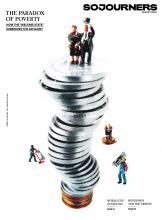IN THE SUMMER OF 2019, I fulfilled one of my childhood dreams: I cheered from the stands as the U.S. Women’s National Team won the FIFA Women’s World Cup in France.
This summer, I’ll be traveling to New Zealand and Australia to watch the team compete to win a third straight World Cup, a feat never before accomplished. I loved every moment of the 2019 tournament — the clutch penalty kicks and the cheeky goal celebrations — but two of my favorite moments came right after the final whistle blew.
The crowd of 57,900, which had been loud the whole game, got even louder.
The first chant was an easy and obvious way to cheer on the new champs: “USA! USA! USA!” I said it a couple times, but not with much gusto. It felt weird. If I said those letters, I wondered, what exactly was I cheering on? Just the team? Or also the U.S. president (at the time, Donald Trump) and his administration’s policies?
Fortunately, the chant shifted to one I could get behind wholeheartedly. As FIFA president Gianni Infantino, head of the international soccer governing body, walked to center field to begin the trophy ceremony, people around me started chanting: “EQUAL PAY! EQUAL PAY! EQUAL PAY!” Drummers behind the goal line punctuated the sound. Within seconds, the whole stadium had joined in.
At the time, a top-performing player on the U.S. Women’s National Team (USWNT) earned only 38 percent of what was earned by a top-performing player on the U.S. Men’s National Team. But as of 2022, the USWNT signed a collective bargaining agreement with the U.S. Soccer Federation that ensures that the national women’s team will be paid at the same rate for game appearances and tournament victories as the men. With this agreement, the U.S. team is setting a powerful global example.
Read the Full Article

